| C H A P T E R 4 |
|
Post Installation |
After completing the Windows 2003 or Windows 2008 installation and rebooting the operating system, you should review the following post installation tasks and, if necessary, perform the tasks that are applicable to your system.
This section describes how to download the server-specific driver packages needed for Windows Server installations.
| Note - If you have the Tools and Drivers CD/DVD and want to use it, you can skip this section and proceed to Installing Server-Specific Device Drivers. However, the latest version of the Tools and Drivers CD/DVD is available as a downloadable image on the Sun download site, which is specified in Download the Server-Specific Drivers. |
|
1. Go to the driver download site for your server.
2. Choose one of the following download options:
| Note - The _x_x_x number identifies the version of the package (for example, FloppyPack_1_1_4.zip). |
3. Proceed to Installing Server-Specific Device Drivers.
Sun provides a wizard to install Sun server-specific device drivers and supplemental software. The server-specific device drivers are provided to support optional devices that you added to the server when you completed the hardware installation or that you may want to add in the future.
The Sun Server Installation Package wizard may be started using one of the following methods:
| Note - Using a recently downloaded InstallPack_x_x_x.exe to update the drivers ensures that you update the server-specific drivers with the latest versions available. |
|
1. Start the Sun Installation Package software using one of the following methods:
The CD will start automatically. At the main menu, select Install Drivers and Supplemental Software.
The Sun Server Install Pack dialog box displays.
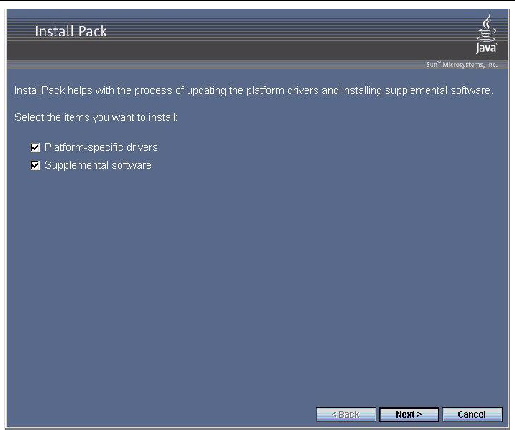
2. Click Next to accept the default settings.
Note that you should always accept the “platform-specific drivers” to ensure that the most recent versions of the drivers are installed.
The Install Pack notice dialog box displays.
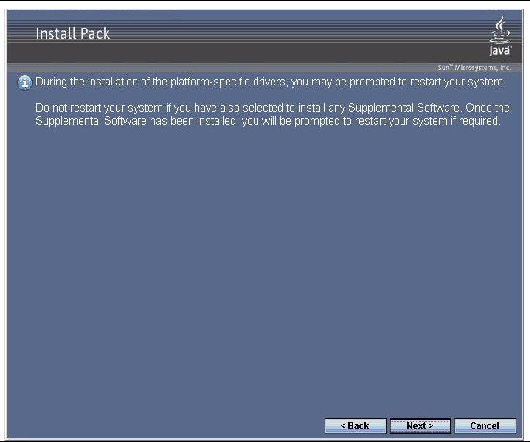
3. Review the Important Note and then click Next.
The Welcome to the Sun Server Installation Wizard displays.
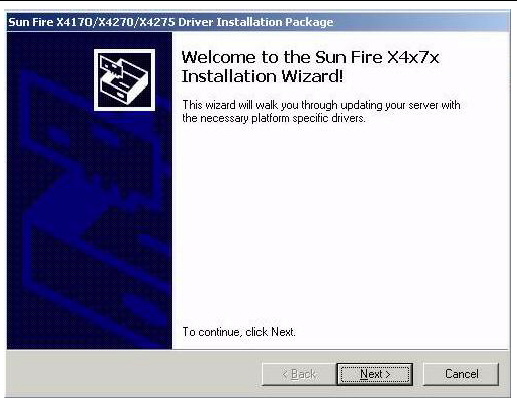
The End User License Agreement page appears.
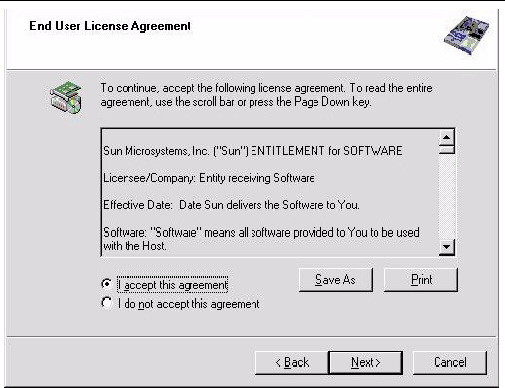
5. Select “I accept this agreement”, and then click Next.
The platform-specific drivers are installed.
In the following screen a green check mark verifies that each driver has been successfully installed.
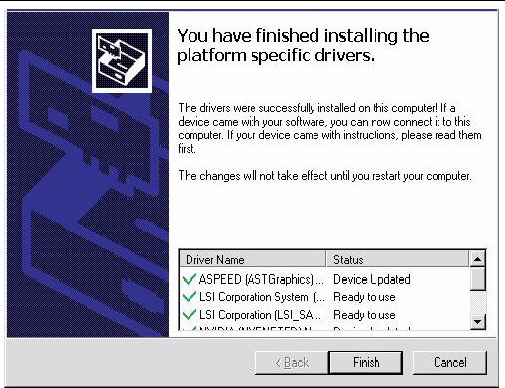
The System Settings Change dialog box displays.

7. If you accepted the default settings in Step 2, click No to proceed to Installing Supplemental Software.
If you are not installing the Supplemental Software, click Yes to restart your computer.
TABLE 4-1 identifies the optional supplemental software components available for your server.
During the supplemental software installation wizard, you can choose to install all the supplemental software (listed in TABLE 4-1) on your system by choosing a Typical installation; or, you can individually select the supplemental software (listed in TABLE 4-1) to install by choosing a Custom installation. For instructions for installing the supplemental software, see Install the Supplemental Software.
|
Allows you to configure, monitor, and maintain RAID on the SAS internal RAID Host Bus Adapter. For information on using MSM, refer to the Sun LSI 106x RAID User’s Guide for your server available at: http://docs.sun.com. |
|||||
|
Allows you to configure, administer and monitor RAID on the Adaptec SG-XPCIESAS-R-IN integrated RAID controller. For information on the Sun STK RAID Manager, see the Sun documentation web site at: |
|||||
|
This utility reads the sensor data repository (SDR) and displays sensor values, System Event Log (SEL), Field Replaceable Unit (FRU) inventory information, gets and sets LAN configuration parameters, and performs chassis power control operations via the BMC (also called the Service Processor). |
|||||
|
IPMI System Management Driver* (Sun Microsystems)-- Windows driver that reads the sensor data repository (SDR) and displays sensor values, System Event Log (SEL), Field Replaceable Unit (FRU) inventory information. This driver is available from the Install Pack media only. Note - This supplemental software is intended for Windows Server 2003 SP2 only. For Windows 2003 R2 SP2, use the inbox Microsoft Driver. For driver configuration instructions, see Configuring Microsoft’s IPMI System Management Driver for Windows Server 2003 R2 SP2. |
|||||
|
Enables the network interfaces on a server to be grouped together into a team of physical ports called a virtual interface. |
|
The Supplemental Software dialog box displays. Proceed to the next step.

2. Click Next to accept the Typical settings, or select Custom to choose the options to install (see descriptions in TABLE 4-1).
Component installation wizards will guide you through the installation of each of the selected supplemental software components.
3. Once the supplemental software has been installed, click Finish.
4. Click Yes at the System Setting Change dialog box to restart your system.
If you ran the Sun Server Installation Package software from the Tools and Drivers CD/DVD, remove the CD from your system now.
5. If you are running Windows Server 2003 R2 SP2 and you have installed the IPMItool supplemental software, you need to configure this driver before you can run the IPMItool.
For instructions, see‘Configuring Microsoft’s IPMI System Management Driver for Windows Server 2003 R2 SP2.
If you are running Windows Server 2003 R2 SP2 and you have installed the IPMItool supplemental software, you need to configure this driver before you can run the IPMItool.
|
Follow these steps to configure the IPMI driver on the Windows Server 2003 R2 SP2 operating system.
1. On your Windows Server 2003 R2 SP2 system, perform the following steps to configure the Microsoft IPMI System Management driver:
a. In Control Panel, open Add/Remove Programs.
The Add/Remove Programs dialog is displayed.
b. Click Add/Remove Windows Components.
The Windows Components Wizard dialog is displayed.
c. Highlight Management and Monitoring Tools component, and then click Details.
The Management and Monitoring Tools page is displayed.
d. In the Management and Monitoring Tools page, perform one of the following:
The 3rd Party Drivers warning dialog appears.
e. Read the warning and then click OK.
The Management and Monitoring Tools page is displayed.
The Windows Components Wizard dialog is displayed.
The Hardware Management component is installed.
2. Instantiate the IPMI System Management driver.
a. In the Taskbar, click Start, and then click Run.
The Run dialog box is displayed.
rundll32 ipmisetp.dll,AddTheDevice
The IPMI System Management driver is instantiated.
3. Open Device Manager and verify that the Microsoft Generic IPMI device exists under the System section.
For information about using the IPMItool, refer to your Sun Integrated Lights Out Manager 2.0 User’s Guide (820-1188). For more information on standard IPMItool commands, see:
http://ipmitool.sourceforge.net/manpage.html
After installing the operating system, you can optionally enable the Wake On LAN (WOL) option in the BIOS Setup utility. This feature enables you to power on the server from another location over the network. For details about the requirements for enabling WOL, see “Wake On LAN - Remote Power On” in the Sun Fire X4170, X4270, and X4275 Servers Service Manual.
The server supports Trusted Platform Module (TPM), however, you must configure it before you can use it. For instructions on how to configure TPM, see the “Configuring Support for TPM” in the Sun Fire X4170, X4270, and X4275 Servers Service Manual.
Copyright © 2009 Sun Microsystems, Inc. All rights reserved.